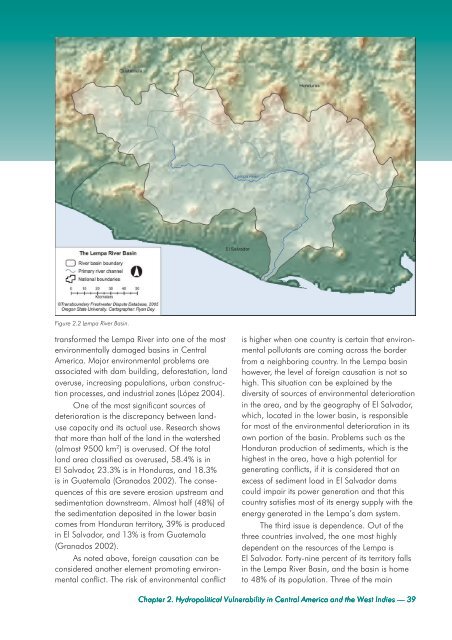Latin America; in English (pdf) - Transboundary Freshwater Dispute ...
Latin America; in English (pdf) - Transboundary Freshwater Dispute ...
Latin America; in English (pdf) - Transboundary Freshwater Dispute ...
Create successful ePaper yourself
Turn your PDF publications into a flip-book with our unique Google optimized e-Paper software.
Figure 2.2 Lempa River Bas<strong>in</strong>.<br />
transformed the Lempa River <strong>in</strong>to one of the most<br />
environmentally damaged bas<strong>in</strong>s <strong>in</strong> Central<br />
<strong>America</strong>. Major environmental problems are<br />
associated with dam build<strong>in</strong>g, deforestation, land<br />
overuse, <strong>in</strong>creas<strong>in</strong>g populations, urban construction<br />
processes, and <strong>in</strong>dustrial zones (López 2004).<br />
One of the most significant sources of<br />
deterioration is the discrepancy between landuse<br />
capacity and its actual use. Research shows<br />
that more than half of the land <strong>in</strong> the watershed<br />
(almost 9500 km 2 ) is overused. Of the total<br />
land area classified as overused, 58.4% is <strong>in</strong><br />
El Salvador, 23.3% is <strong>in</strong> Honduras, and 18.3%<br />
is <strong>in</strong> Guatemala (Granados 2002). The consequences<br />
of this are severe erosion upstream and<br />
sedimentation downstream. Almost half (48%) of<br />
the sedimentation deposited <strong>in</strong> the lower bas<strong>in</strong><br />
comes from Honduran territory, 39% is produced<br />
<strong>in</strong> El Salvador, and 13% is from Guatemala<br />
(Granados 2002).<br />
As noted above, foreign causation can be<br />
considered another element promot<strong>in</strong>g environmental<br />
conflict. The risk of environmental conflict<br />
is higher when one country is certa<strong>in</strong> that environmental<br />
pollutants are com<strong>in</strong>g across the border<br />
from a neighbor<strong>in</strong>g country. In the Lempa bas<strong>in</strong><br />
however, the level of foreign causation is not so<br />
high. This situation can be expla<strong>in</strong>ed by the<br />
diversity of sources of environmental deterioration<br />
<strong>in</strong> the area, and by the geography of El Salvador,<br />
which, located <strong>in</strong> the lower bas<strong>in</strong>, is responsible<br />
for most of the environmental deterioration <strong>in</strong> its<br />
own portion of the bas<strong>in</strong>. Problems such as the<br />
Honduran production of sediments, which is the<br />
highest <strong>in</strong> the area, have a high potential for<br />
generat<strong>in</strong>g conflicts, if it is considered that an<br />
excess of sediment load <strong>in</strong> El Salvador dams<br />
could impair its power generation and that this<br />
country satisfies most of its energy supply with the<br />
energy generated <strong>in</strong> the Lempa’s dam system.<br />
The third issue is dependence. Out of the<br />
three countries <strong>in</strong>volved, the one most highly<br />
dependent on the resources of the Lempa is<br />
El Salvador. Forty-n<strong>in</strong>e percent of its territory falls<br />
<strong>in</strong> the Lempa River Bas<strong>in</strong>, and the bas<strong>in</strong> is home<br />
to 48% of its population. Three of the ma<strong>in</strong><br />
Chapter 2. Hydropolitical Vulnerability <strong>in</strong> Central <strong>America</strong> and the West Indies — 39
















